HDTV SLIDE SHOWS
Sony Cyber-shot Station CSS-HD1
 By MIKE PASINI
By MIKE PASINIEditor
The Imaging Resource Digital Photography Newsletter
Review Date: April 2007
The Cyber-shot Station CSS-HD1 isn't Sony's first dock, but it's the first one to offer component output to high definition television so you can enjoy your images in all their glory. Like its predecessors, it can charge the battery in a compatible camera when docked and output a standard TV signal, too. But there's no USB port to transfer images to your computer. This dock is designed to connect to your TV, not your computer.
You can view individual images, slide shows with sound and even navigate your Sony digicam's menu system. Movie output depends on the camera, but the Sony T100 we tested captured only 640x480 and 30 fps at best, which the Station could play only through the VGA connection. A remote control that operates up to about 15 feet away lets you run the presentation through the camera.
With a list price of $79.99, it's only about $30 more expensive than a set of component cables (which still require a set of audio cables). Not a bad deal when you factor in the fast battery charger, too. If you have a compatible camera. Those models include Cyber-shots DSC-W80, DSC-W90, DSC-T20 and DSC-T100.
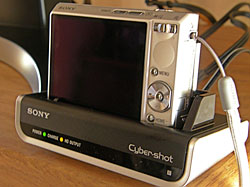
Mounted. The slim dock with a silver T100 mounted.
All of those models feature HD still output. Sony told us at a briefing earlier this year that they expect people to gravitate toward HD televisions for two reasons: HDTVs offer better color and detail over standard television and also a more pleasant viewing experience (in one of those theater seat recliners that seat six) than huddling around a small computer monitor (fighting over the one office chair). With the installed base of HDTVs growing rapidly, Sony plans to offer HD output in all its Cyber-shot products starting with this model year.
You can opt for a cable connection from these cameras to a component input. But it's nearly as expensive as the more permanent dock that adds a remote control and battery charging. Sony also offers a $149 printer/dock solution.
COMPONENT VIDEO | Back to Contents
Let's go back to school to get the story on how this works.

Component Cables. The five RCA plugs (red through white) are from the Station. Three are for video signals with the red and white on the far end for audio.
A standard analog video signal like NTSC or PAL combines video information in a single line level signal output on a yellow RCA plug. On a digicam, you select NTSC or PAL and plug the AV cable into the camera's AV jack and the yellow RCA plug into your TV set's yellow video in port. Then you tell the TV to look for a signal on that port, rather than the antenna or cable box connection. You get 640x480 resolution images downsampled from your originals.
Component video, which may be either digital or analog, splits the video information into three separate signals. The RCA jacks are color coded so you get them right when you connect them to component inputs on your standard or HD television. The advantage of separating the video information into separate signals is that it avoids any interference, maintaining a cleaner signal. And the resolution of that signal is 720 or 1080 lines compared to the 480 lines of standard video.
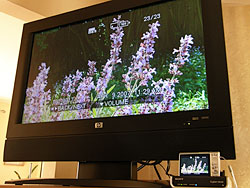
HD Image Display. You can see both the 3-inch LCD display on the T100 and the 32-inch HDTV display of the same image.
Notice, though, that we're only talking about video here. So to convey both video and audio to your TV, you typically connect five RCA jacks to it: the three component video connections and the two audio connections for the left and right channels.
Sony has opted to supply an analog YPbPr signal out of the Station through a custom jack. Audio also uses a custom jack in the back on the Station but includes a standard TV yellow jack as well on that cable. Both cables are provided with the Station.
To see your images and VGA movies at the standard NTSC 640x480 signal, you use the yellow video plug attached to the same cable as the red and white audio plugs (and pull out the component connection at the Station). To see your images at high definition, you use the component video cable, which trumps the yellow video connection. And, just like your old TV, you have to select the appropriate input source on the TV to see that signal.
IN THE BOX | Back to Contents
The Cyber-shot Station CSS-HD1 ships with the following items in the box:
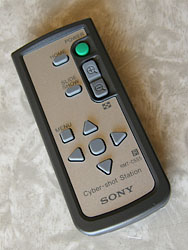
Remote Control. There's a dedicated Slide Show button and you can even control volume with the Up and Down arrows via the camera's output to the TV.
- Cyber-shot Station CSS-HD1
- Wireless remote commander RMT-CSSS with button type lithium battery installed
- 100-240V AC adapter
- AC power cord
- AV cable
- Component video cable
- Printed documentation and warranty
FEATURES | Back to Contents
The main features of the Cyber-shot Station CSS-HD1 are:
- It permits viewing still images in the camera in high definition on an HDTV.
- Images, slide shows, movies and zoom can be control by a remote control.
- Slide shows with sound (configurable via the remote on the camera) can be started with the Slide Show button on the remote.
- The Cyber-shot Station can charge the battery pack in the camera faster than the charger supplied with the camera.
At 5 x 1-13/16 x 2-5/8 inches (124 x 45 x 65mm) and 3.2 ounces (90 grams), the Station is small but so lightweight that, without a camera attached, it can be lifted up by the weight of the cables themselves.
INSTALLATION | Back to Contents
Installation was quick and easy:
- Set the Model Select switch on the dock itself to either A (for the W200, W90, W-85, W80 models) or B (for the T100, T25 or T20 models).
- Connect the AC adapter to the DC In jack on the dock.
- Connect the AC power cord to the adapter and plug it into a wall outlet. The adapter can be used internationally with the right plug adapter.
- Connect the AV cable to the AV jack on the station and the red and white analog audio connections on your television set. You can optionally attach the yellow video plug to a yellow video input for standard video display. But don't bother if you are using the component cable (which gets the video signal if attached).
- If you have an HDTV, connect the component video cable's green, blue and red jacks to the Y, Pb and Pr jacks of your HDTV. Audio will be transmitted over the red and white jacks you connected in the previous step.
- Remove the insulation sheet from the remote control battery by removing the battery drawer and sliding it off the battery.
That's all there is to it.
USING THE STATION | Back to Contents
To use the station, start with both your TV and camera powered off. The camera should not have any lens attachments on either. If you want to view images on the camera's internal memory, remove the memory card.
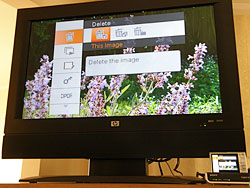
Menu Display. You can set options on the camera using the included remote.
Turn on the camera by either pressing its Playback button or the Power button on the remote control.
Once the station is sending out a signal, turn on your TV and select the appropriate input source. You'll see the camera's output on your TV.
Slide show. To watch a slide show, just press the Slide Show button. Pressing the button again, cancels the show. You can use the Menu button to change the options for the slide show's transitions, pan and zoom effects, and music just as you would on the camera. In fact, you're controlling the camera with the remote through the station.
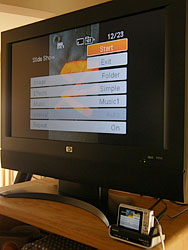
Slide Show Menu. The T100 displays its slide show options on the big screen.
Pop the camera in the station with the LCD facing you, aligning the camera to the right corner of the station to make it easy.
The Charge light should blink for a few seconds as the camera and station communicate, then glow steadily to indicate the battery is charging. A full charge can require about 230 minutes.
THE CAMERA CONNECTION | Back to Contents
The Station is only as good as the Sony digicam attached to it. Fortunately, Sony's new W and T Series Cyber-shots are all up to the task.
Among the most improved Cyber-shot features is a built-in slide show function whose sophisticated transition styles and music selections can be mixed and matched in the Setup screen.

In Progress. A slide show in progress on the big screen.
But the cameras also include Sony's new face detection technology, which can identify up to eight faces in the scene and automatically adjust white balance and flash output.
But you may not need flash with Sony's Super SteadyShot optical image stabilization technology and ISO sensitivity as high as 3200. High ISO also enjoys Sony's Clear Raw noise reduction technology to improve picture quality.
The T Series adds the Bionz processing engine from Sony's Alpha dSLR system. In addition to fast image processing, the Bionz makes the T digicams more responsive and extends their battery life.
We used a T100 on the Station to display a variety of image formats, including a 16:9 image format ideal for HDTV.
The T100's slide show menu has a number of options, including:
- Image: Restricts playback to images in a specific folder or includes all the images on the memory card.
- Effects: Simple (a simple slide show with dissolves and calming music appropriate for most subjects), Nostalgic (a sepia monochrome slide show with dissolves), Stylish (more dramatic transitions at a quicker pace), Active (a high-tempo pace) and Normal (basic transitions at regular intervals). Normal shows can play movies but don't play music. All the other options play music.
- Music: Music1 is the default for Simple effects, Music2 for Nostalgic, Music3 for Stylish, Music4 for Active and Off for Normal, which plays movie audio. You can optionally load your own CD or MP3 music files up to 180 seconds long from a computer using Sony's Music Transfer software and a USB connection to the camera.
- Interval: The interval is set by the option chosen in the Effects menu. The interval used by a Normal slide show, however, can be set with this option to 3/5/10/30/60 seconds.
- Repeat: Toggles whether the playback loops or not.
The various slide show presentations were pretty impressive, even on a standard TV. Not quite the quality of a muvee presentation but not far behind either. Images were panned and zoomed (but not rotated) and the zoom moved to multiple points in an image. Some effects actually assembled an image on the screen in panels.
A Slide Show. Play the movie to see for yourself.
Considering the camera has no idea what the subject of the image is, the effects were pleasing and heightened interest. Yes, you could do better if you took the time to create your own show, but for an instant presentation this was pretty impressive. Your audience will think you did take the time to create it from scratch.
Seeing high resolution images on a high definition screen viewable from anywhere in the room was a real pleasure, too. There's enough data for the images to be zoomed without seeing pixels and the color was brilliant (but that, of course, depends on the quality of your HDTV).
The only drawback to this arrangement is that you're dedicating a component connection on your TV to one camera. That might not matter much now, given the paucity of options, but tying up a port for each device isn't a feasible approach. The alternative is something like Apple TV (http://imaging-resource.com/ACCS/ATV/ATV.HTM), which doesn't care which camera took the pictures and provides elegant transitions with your own music and engaging screen savers featuring your images.
CONCLUSION | Back to Contents
For the price of the cables at Radio Shack, Sony delivers a fast battery charging dock that taps into your Cyber-shot W or T Series digicam to play high definition slide shows with music on your HDTV. You can also connect it to a standard television which will display the slide shows at normal resolution. Using the included remote, you can even change slide show settings and navigate the images on your memory card or internal memory.
The slide shows are impressive, considering they're automatically created, great fun for the family or friends either during or after the party. Coupled with the 2007 Cyber-shot line's high ISO and Super SteadyShot image stabilization, the Station is going to be welcomed at any party, in fact.
You may have to adjust your HDTV to optimize color display, but the results will be worth it. You get high resolution display and a comfortable viewing environment (the couch if not theater seating) to enjoy your images. That makes the Station a great accessory for any 2007 W or T Series Sony Cyber-shot.